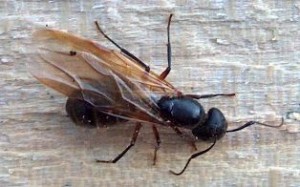 The following is simply some basic information about common pests in the home. If you have a pest emergency or any additional questions, call us or email This email address is being protected from spambots. You need JavaScript enabled to view it..
The following is simply some basic information about common pests in the home. If you have a pest emergency or any additional questions, call us or email This email address is being protected from spambots. You need JavaScript enabled to view it..
In some areas of the country, particularly the northeast, carpenter ants (wood ants) can cause more damage to structures than termites. They are difficult insects to control and are often associated with damage to the wood in a structure. This damage can happen in a fairly short period of time. They favor moist wood as a habitat and usually the water intrusion has already caused damage, the carpenter ants are simply making a bad situation worse. As a rule, they just like to make a home in the moist conditions.
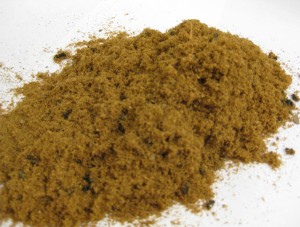 Carpenter ants are omnivorous, eating many different types of food, including plants and animals as well as their own dead. Unlike termites, they do not actually eat wood but excavate galleries within it to use as nesting sites. Sometimes wood particles, resembling pencil shavings, are found in areas where carpenters are excavating holes for nesting. These wood particles are referred to as “frass”. Upon closer inspection of the frass you may notice parts of ants, i.e. head, body segments, some legs, more often there is no evidence.
Carpenter ants are omnivorous, eating many different types of food, including plants and animals as well as their own dead. Unlike termites, they do not actually eat wood but excavate galleries within it to use as nesting sites. Sometimes wood particles, resembling pencil shavings, are found in areas where carpenters are excavating holes for nesting. These wood particles are referred to as “frass”. Upon closer inspection of the frass you may notice parts of ants, i.e. head, body segments, some legs, more often there is no evidence.
At the least, carpenter ants are difficult to find when nesting within a structure. It is not uncommon for them to nest between the paper backing of insulation and the sub-floor of a basement or crawlspace. Also around windows, especially the lower part, if there are past or present water problems. They can nest comfortably between exterior plywood sheathing and the foam wrap of vinyl siding, chewing and removing the foam insulation as needed. If the chimney flashing has been compromised, moisture can get in, causing a suitable spot for nesting, and perhaps the most insidious spot, in my opinion, is when they nest between the roofing shingles and the sub-roofing. So with this said, do you really think you are adequately prepared to solve your carpenter ant problem yourself.
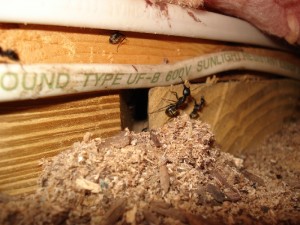 When foraging inside houses, carpenter ants are attracted to sweets, meat, grease and fat. Foraging activity can occur at any time of day but usually peaks at night. The ant achieves pest status when a colony invades the wood of a house, possibly causing damage and just being an overall nuisance. If winged ants are seen, there is a colony not far behind, so do not ignore this important warning sign. Structural damage can be intense by the time external damage is visible, such as sawdust or bubbling paint.
When foraging inside houses, carpenter ants are attracted to sweets, meat, grease and fat. Foraging activity can occur at any time of day but usually peaks at night. The ant achieves pest status when a colony invades the wood of a house, possibly causing damage and just being an overall nuisance. If winged ants are seen, there is a colony not far behind, so do not ignore this important warning sign. Structural damage can be intense by the time external damage is visible, such as sawdust or bubbling paint.
A carpenter ant colony is usually formed by a queen, who begins a nest in a piece of old buried wood or in a partially decayed tree or stump. A carpenter ant colony has a very structured castedef. system consisting of the Queen, smaller winged male reproductives’, worker major, worker medium, and worker minor.
Note the next time you see a fallen tree hollowed out, that damage is likely done by carpenter ants. In mature infestations, there may be as many as ten satellite colonies, or more, linked to the parent/main colony by scent (pheromone) trails. There is a frequent exchange of workers between these satellite colonies and the main nest. Colonies normally do not produce winged reproductive until they are at least three to six years old with emergence of swarmers typically occurring from May through July.
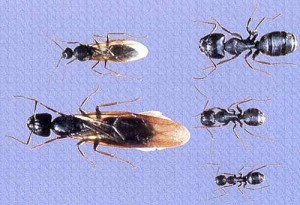 The most common way in which homes become infested is through emigration of an existing colony. Houses located near wooded areas, or brush covered vacant lots are good candidates for infestation. Carpenter ant colonies are inclined to move if they are disturbed, as often happens during construction. Thus, new homes or those surrounding a new building lot present likely locations for attack.
The most common way in which homes become infested is through emigration of an existing colony. Houses located near wooded areas, or brush covered vacant lots are good candidates for infestation. Carpenter ant colonies are inclined to move if they are disturbed, as often happens during construction. Thus, new homes or those surrounding a new building lot present likely locations for attack.
Homeowners will often try to solve this problem by way of home remedies and/or over the counter products. Sometimes with success, usually it simply makes the situation worse either by causing the ants to scatter to new locations, or go dormant, sometimes as long as 7-9 months, lending to a false sense of success only to have a worse problem next year. When trying to solve the problems themselves, homeowners will use over the counter repellent products that are counterproductive to a professionals efforts.
Carpenter ants are very hardy insects with strong nesting and foraging behaviors. These insects can do structural damage and require diligence for proper control. Carpenter ants may very well be the #1 cause of pest damage to homes in the northeast, and there treatment should not be taken lightly. You need to understand some important facts regarding behavior of these insects, and the materials used, so as to better understand what we do and why.
The residual (effectiveness) of the materials that we have available to us today are roughly 3 months, probably less. I am not aware of any exceptions.
Repeat applications are necessary to maintain a protective barrier. Proper maintenance of this barrier can greatly reduce the likelihood of infestation.
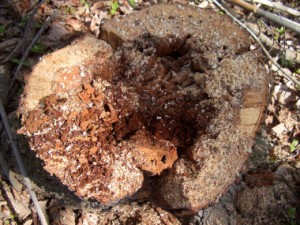 Carpenter ants can forage great distances from their nest for food and shelter (200 to 300 feet). When adequate food or shelter is found, these “scout ants” will provide a scent trail (pheromone trail) back to the main colony, recruit other ants, and follow the provided scent trail back to the source of food or shelter. The stronger the scent trail, the stronger the foraging instinct.
Carpenter ants can forage great distances from their nest for food and shelter (200 to 300 feet). When adequate food or shelter is found, these “scout ants” will provide a scent trail (pheromone trail) back to the main colony, recruit other ants, and follow the provided scent trail back to the source of food or shelter. The stronger the scent trail, the stronger the foraging instinct.
As the protective barrier begins to break down, foraging patterns can begin to re-establish trails back to your home. These trails can be across the surface of the ground next to your home, on wires connected to your home, or tree branches touching your home. This strong foraging behavior and the length of the residual of the materials used is why we recommend at least 3-seasonal applications.
The 3-season application provides protection against these pests when they are most active. For Carpenter Ants- Spring; is first emergence when carpenter ants are looking food for the colony. The colony is typically in the woods/forest. Summer; is the height of activity often foraging for food, water, and shelter. Fall; is a time when insects prepare to “over winter”. Shelter becomes the dominant theme this time of the year.
Carpenter ants are very cryptic in their behavior; often they are the most active between the hours of 10:00pm & 4:00am. Their presence and damage can often go undetected for long periods of time.

